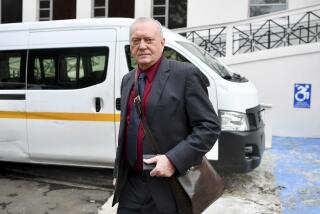B of A Cleared of Charges It Abused Trusts
- Share via
Bank of America was absolved Wednesday of accusations that it used trust funds “for (its) own benefit and profit” rather than for the good of the beneficiaries.
Los Angeles Superior Court Judge Lester E. Olson ruled in the bank’s favor in a 6-year-old class-action civil suit filed by three trust beneficiaries, Ted E. Van de Kamp, a cousin of California Atty. Gen. John Van de Kamp; Jo Ann Williams, and the Damon Runyon-Walter Winchell Cancer Foundation.
The case had been watched by bank trust departments across the country, which feared that an adverse ruling would necessitate a major revamping of their investment and managerial practices, Bank of America attorney Charles G. Bakaly Jr. said.
Accused of Mismanaging The beneficiaries had claimed that, since at least 1967, the San Francisco-based bank had violated its duty as trustee by mismanaging the funds in three ways:
- By “self-pooling,” or pooling and using for its own benefit cash balances in the accounts of beneficiaries, retaining the interest earned.
- By “fail float,” or charging trust accounts for the purchase of securities five days after the deal was made but paying for the securities when they were physically delivered some time later, investing the purchase money in the interim and pocketing the revenue from it.
- And by “disbursing float,” or charging trust accounts immediately when checks were prepared to pay trust obligations and transferring the money to the bank’s own account until the checks were returned to the bank for collection, again retaining the revenue earned.
In each case, however, the judge stated in his 14-page decision: “The bank has adequately explained and justified its conduct.”
Deciding that the bank had acted properly as trustee, Olson noted: “The bank could be held liable as to any of the alleged wrongful practices only if it were possible to conclude that the bank had superior technological and managerial capability which it failed to apply to trust management, to the detriment of trusts.”
That, he said, was not the case.
“The evidence in this trial involved a microscopic examination of many of the most significant and complex aspects of the operation of the daily affairs of the world’s largest bank,” noted Olson, who used his personal computer to track the 1,504 exhibits and 49 witnesses during the 38-day non-jury trial.
As to the self-pooling charge, Olson said that both federal and state law permit banks to self-deposit trust cash and that the bank acted properly in investing short-term cash in its own savings accounts.
The bank’s practice before 1976 of leaving $100 uninvested in trust accounts, he said, was necessary for administering the trusts, just as if the trust account were like a checking account with a fee.
As for the fail float, Olson said that using the contractual settlement date--five days after purchase--for removing funds from trust accounts to pay for securities was consistent with generally accepted accounting practices. Using the trade date--when securities are delivered--he added, is neither feasible nor in the trust beneficiaries’ best interests.
Although the bank occasionally benefited, Olson said, evidence showed that the bank, which occasionally “loaned” money to the trusts without interest, more often lost money by the arrangement.
To handle security purchases on split-second actual transfer dates, Olson said, would require an unwarranted and costly computerized operations system.
As for the disbursing float on checks, Olson said that allowing the bank to use money while a check clears is a generally accepted accounting practice and that the system is the most practical for trust accounts.
Although he ruled generally in favor of the bank, Olson rejected the bank’s arguments that the case should be handled as separate suits by trust beneficiaries rather than as a class action and that beneficiaries had delayed too long in filing the suit.
More to Read
Inside the business of entertainment
The Wide Shot brings you news, analysis and insights on everything from streaming wars to production — and what it all means for the future.
You may occasionally receive promotional content from the Los Angeles Times.










